You land in Lisbon, your outdoor walking tour is rained out – and suddenly, your phone suggests indoor museums, cozy cafes, and local concerts that match your interests. It's seamless, personalized, and supposedly powered by generative AI. But how much of this is real innovation, and how much is marketing hype?
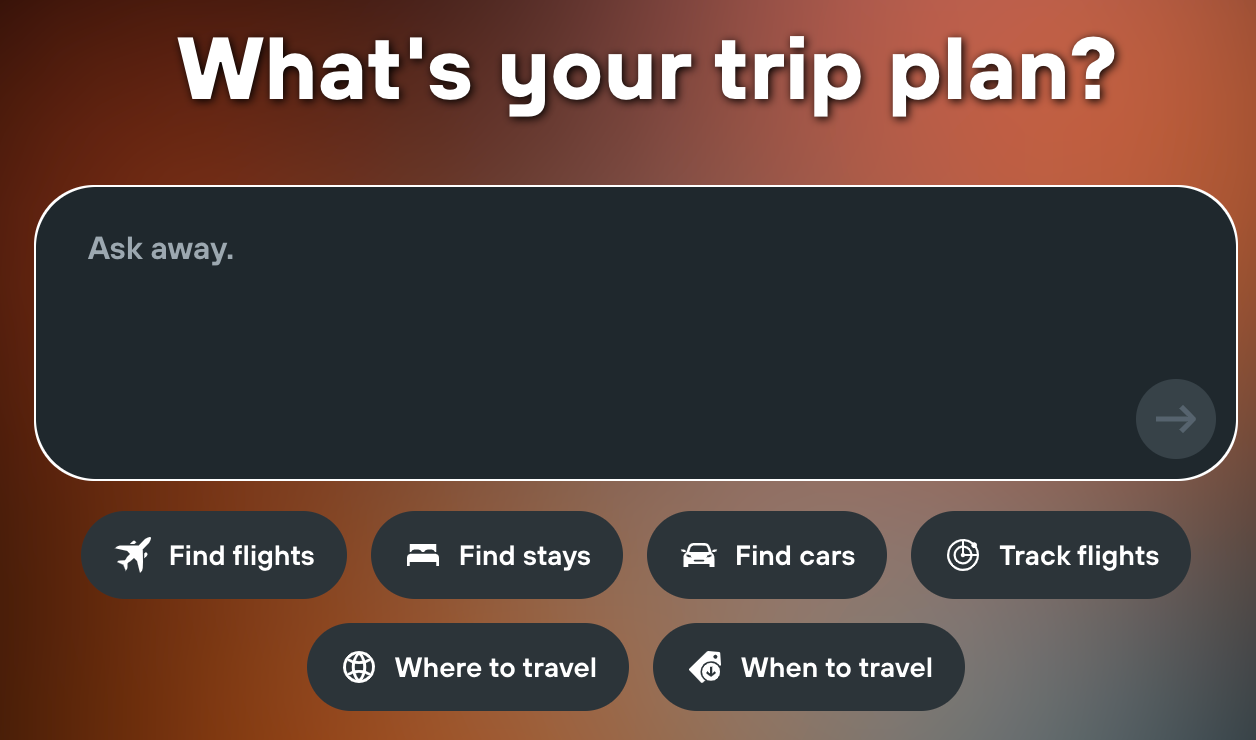
Travel agents are cool again. They’re not human, though. Source: Kayak.ai
As AI tools rapidly enter the travel and tourism space, companies promise everything from smarter itineraries to fully automated customer service. In this article, we take a closer look at what’s actually happening behind the scenes: where generative AI is already making an impact, where it's falling short, and what the future might really hold.
A quick look at how gen AI works
Generative AI is a branch of machine learning that focuses on creating content – such as text, images, audio, video, or code – based on patterns learned from existing data.
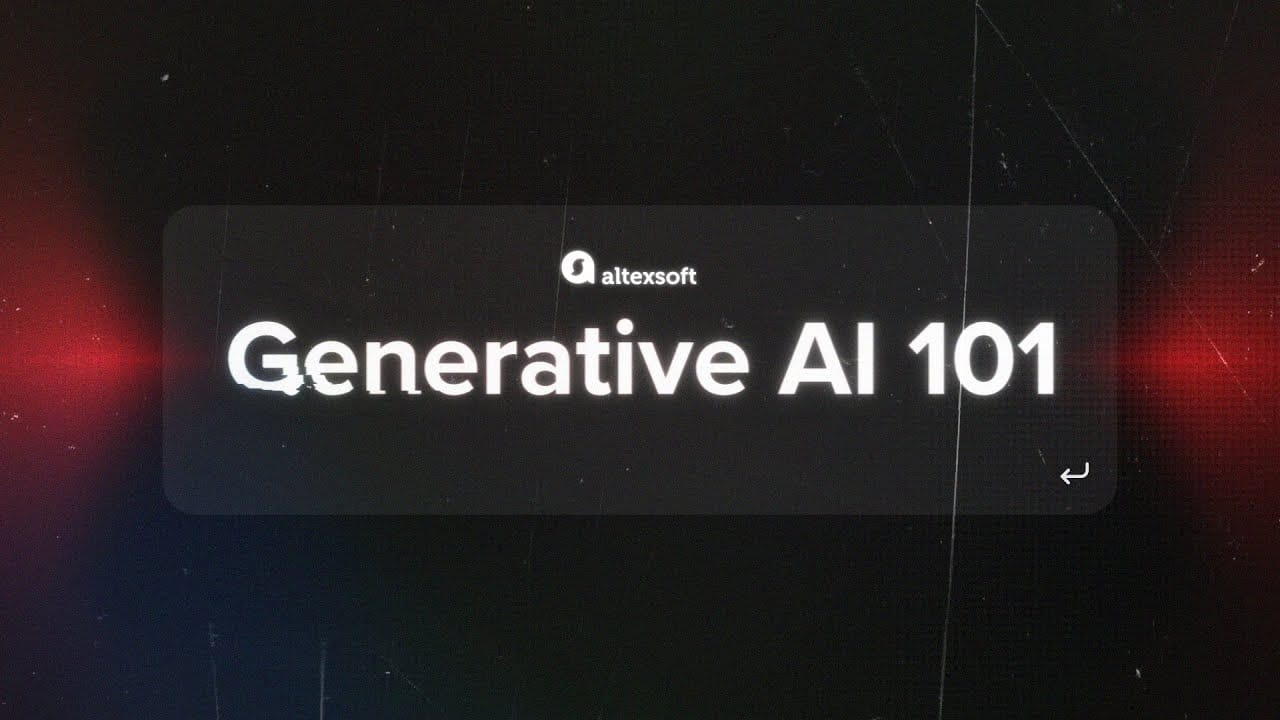

How Generative AI Works
For text, the model predicts the next word or phrase based on context, generating coherent and contextually relevant sentences. For images or videos, it predicts pixels or frames by learning visual patterns, textures, and spatial relationships from large datasets. Audio and music generation works similarly, with the model learning patterns in waveforms, pitch, and rhythm.
This capability enables tools that can create visuals, summarize reviews, suggest destinations, craft personalized itineraries, and answer customer questions in a conversational way.
However, the effectiveness of these systems depends heavily on the quality of the underlying data and the integration with real-time travel information. While they can produce highly useful recommendations and content, AI outputs may still be inaccurate or incomplete without human oversight, highlighting the difference between real innovation and marketing hype.
“Large companies are already integrating AI, mainly for efficiency and personalization. But the real transformative potential of AI is in changing entire business models — something we haven’t seen yet,” says Tomotaka Hirabayashi, leader for the Data Driven Re-Design Strategy Team at EY and committee member of the Japan Tourism Agency. “Right now, most companies use AI to improve what they already do, not to reinvent their approach. There’s a big gap between expectations and reality.”
To explore this gap closer, let’s talk about the most prominent use cases for generative AI in travel.
Key use cases of generative AI in travel
There are a few key areas in tourism where generative AI has the most promise. Let’s review the largest use cases, their potential, and actual impact.
Conversational search and discovery
While generative models are designed to create content, agentic AI takes it a step further by taking actions towards the goal.
Agentic AI adds autonomy: it can decide whether to answer directly or call external tools to fulfill a request. For example, if a traveler asks about weather or flight availability, an agentic system can query APIs, combine the information, and return a tailored response, all while reasoning about what to do next. This makes search and discovery more dynamic, proactive, and capable of handling complex, real-world traveler needs.
This technology has a potential to change the way travelers interact with search by enabling conversational, open-ended queries rather than rigid form fields. Instead of selecting destinations, dates, and amenities from dropdown menus, users can describe what they want in natural language, such as “a quiet cabin with a fireplace near a lake, but not too remote.” The AI interprets this intent and suggests results that might not appear through conventional filters.
“In the offline era, travel agents played that role by listening to travelers’ needs and building itineraries,” says Tomotaka. “In the online era, OTAs shifted to simply listing inventory. In the AI era, OTAs could evolve back into intermediaries – interpreting traveler demands expressed through AI and matching them with suppliers.”
How does it currently work in practice?
Mindtrip is an AI travel planning startup that enables users to create personalized, visual itineraries from simple prompts, such as a keyword, a photo, or even a URL. Travelers can interact with the assistant to refine their plans: select hotels, attractions, dining options, and activities, which the system presents via maps, reviews, photos, and booking links while simultaneously updating an exportable itinerary and calendar view. Thanks to its partnership with Priceline, Mindtrip allows travelers to book hotels and flights directly on the platform. Similarly, Viator powers its tour booking and content capabilities.
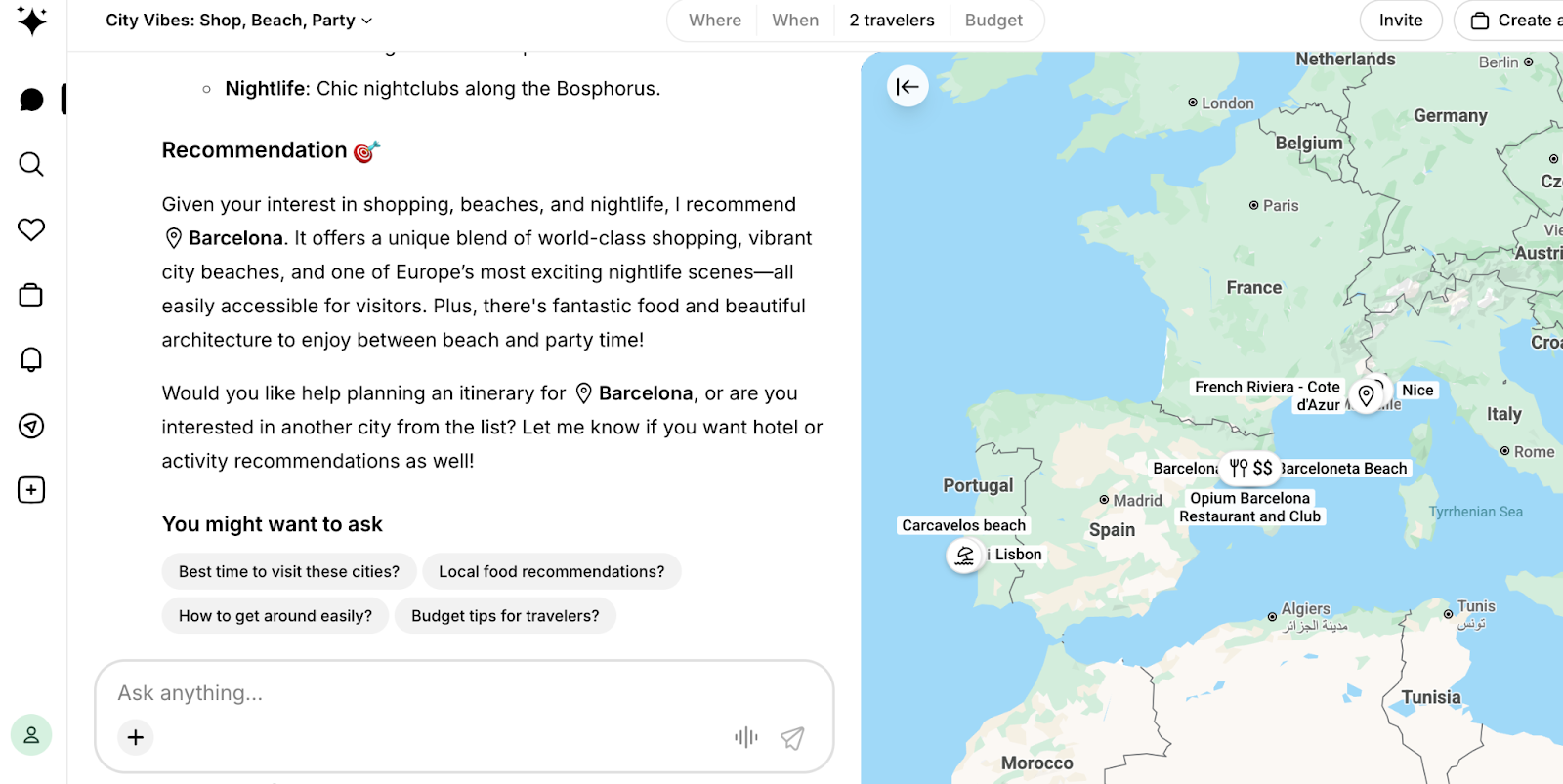
Mindtrip offers instant recommendations from vague queries
Expedia went even further and introduced a Trip Matching feature that builds itineraries based on Instagram Reels. Capitalizing on the young people’s habit to draw travel inspo from social media, they allow the users to share a video to Expedia account, which will reply with personalized recommendations and itineraries based on the video.
Trivago’s Smart AI Search is powered by a close collaboration with Google’s Vertex AI. Trivago integrates AI into the core of its search engine, combining semantic understanding with traditional keyword matching, filtering, and post-processing to deliver more nuanced results. The development process revealed both technical and human challenges – notably, that many users struggle to express preferences before seeing hotel options. This insight led to a focus not just on backend AI performance, but also on user interface and interaction design.
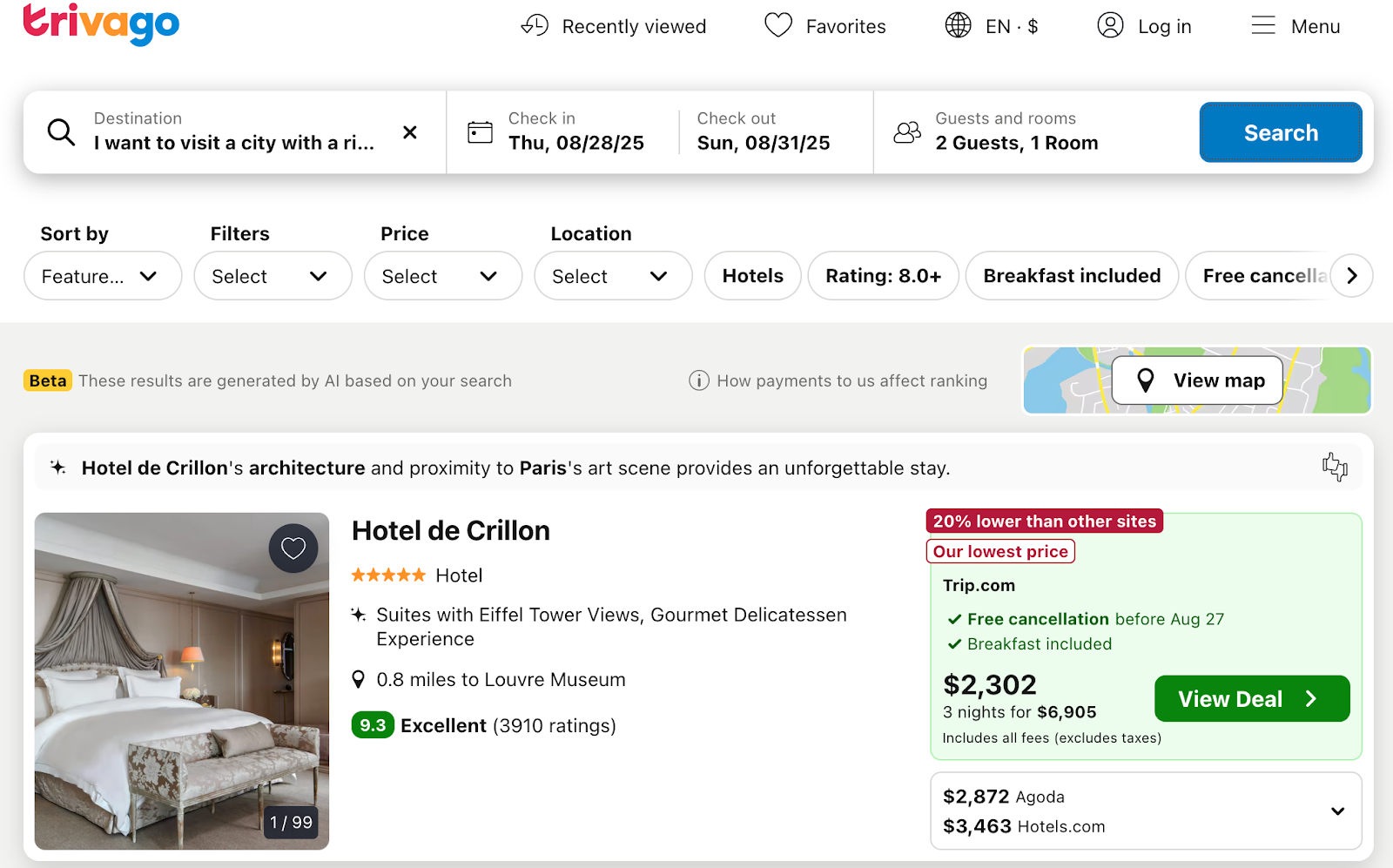
Trivago combines traditional search results with AI-powered suggestions
Developed along with OpenAI, Kayak.ai provides recommendations on flights, stays, and cars, as well as supporting flight status tracking, suggesting destinations and cheapest times to visit them. While the same feature has been introduced to Microsoft Copilot, Kayak seems to be dedicated to expanding its Kayak.ai interface as an alternative to the usual website.
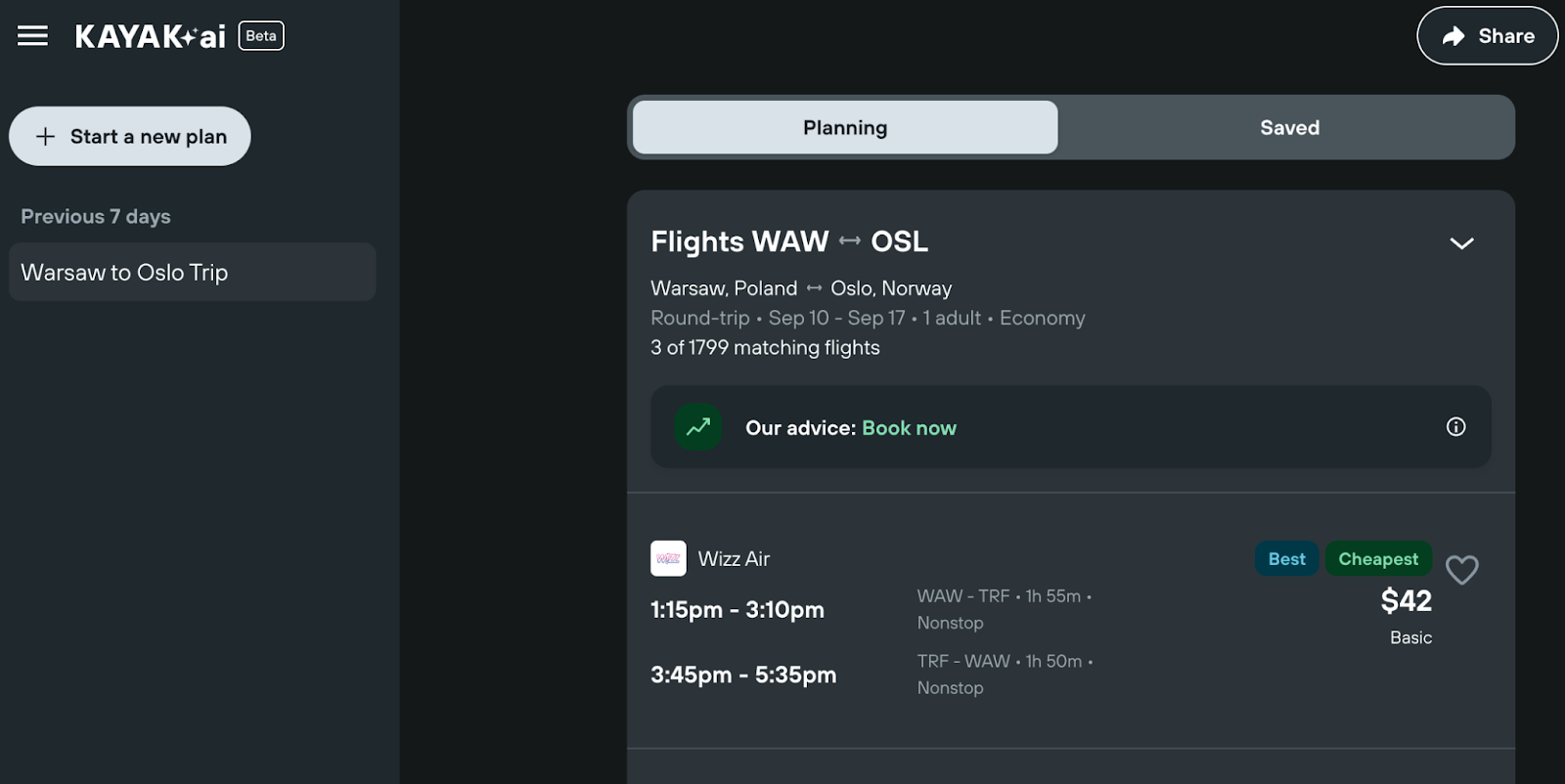
Kayak’s chat interface is minimalistic while containing all the important details
Priceline’s travel AI assistant Penny has been developed on top of Google Cloud’s Vertex AI and OpenAI’s GPT-4 Turbo. It handles flights, car rentals, and vacation packages, enabling users to plan, book, and modify trips with personalized recommendations. The iOS app can generate full itineraries with activities, restaurants, and attractions. Additional features include Priceline Wallet for managing coupons and airline credits, and Price Watch for tracking fare changes.
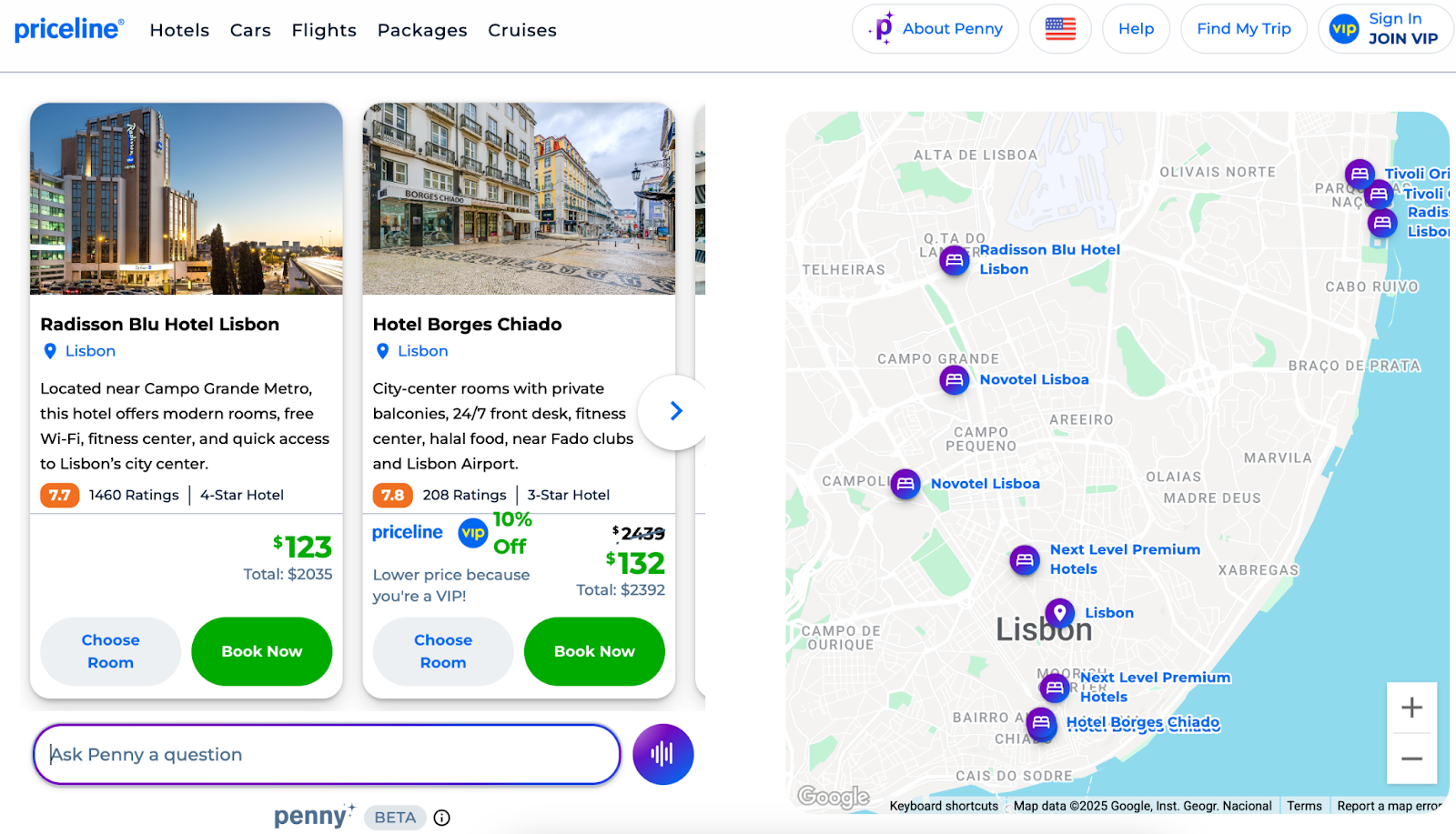
With Penny, you can book directly from the chat
According to Phocuswright’s Consumer Travel Report 2025, the use of AI for travel planning is steadily growing. And one in three US travelers are already using gen AI for travel-related purposes.
“The challenge is trust,” adds Tomotaka. “Generative AI sometimes provides inaccurate information, which makes travelers cautious. But in two to three years, as AI becomes more sophisticated, I believe it will replace search engines like Google as the main entry point for travel planning, eventually including bookings.”
Review summarization
One of the clearest applications of generative AI in travel today is review summarization. Travelers are often overwhelmed by thousands of user reviews, making it difficult to extract meaningful insights. Generative AI has the potential to cut through that noise, condensing reviews into concise, theme-based summaries that highlight what matters most – whether it’s Wi-Fi speed, cleanliness, location, or breakfast quality.
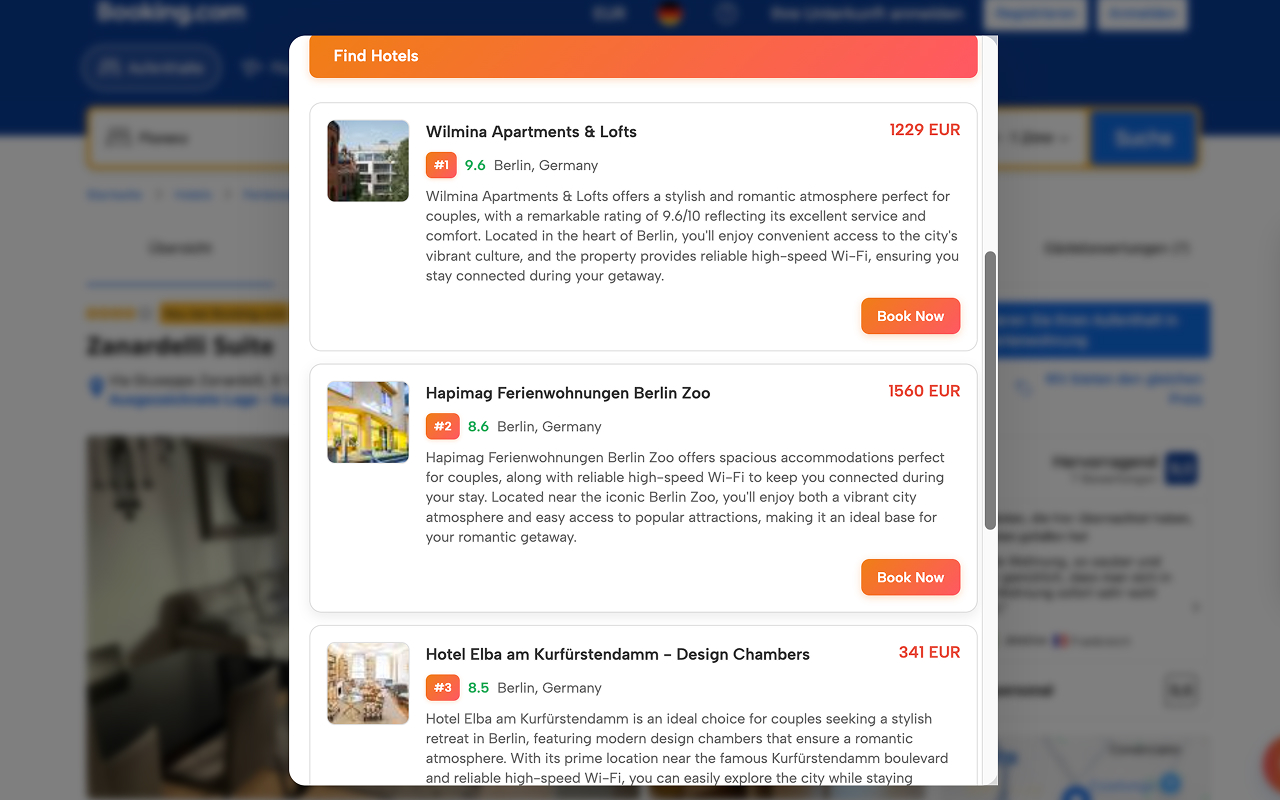
Review summaries generated by Revyu. Source: Chrome Web Store
The process works by combining structured data, such as ratings and amenities, with unstructured review content. AI models analyze language patterns, identify recurring themes, and distill key points into readable summaries.
For example, there’s Revyu, a free Chrome extension that summarizes and answers questions about guest reviews in real time, directly on popular platforms like Booking.com, Expedia, and Tripadvisor. So one can also ask specific questions like “Is the Wi‑Fi fast?” or “Are rooms quiet at night?” and Revyu provides concise answers sourced from actual guest feedback, all without requiring signup.
Tripadvisor, being the biggest travel review website, was also quick to act on the gen AI potential. Presented as short sections on top of user reviews, Tripadvisor’s AI summaries highlight popular themes and frequently mentioned attributes. Clicking on each highlighted parameter allows users to see all related reviews written by users.
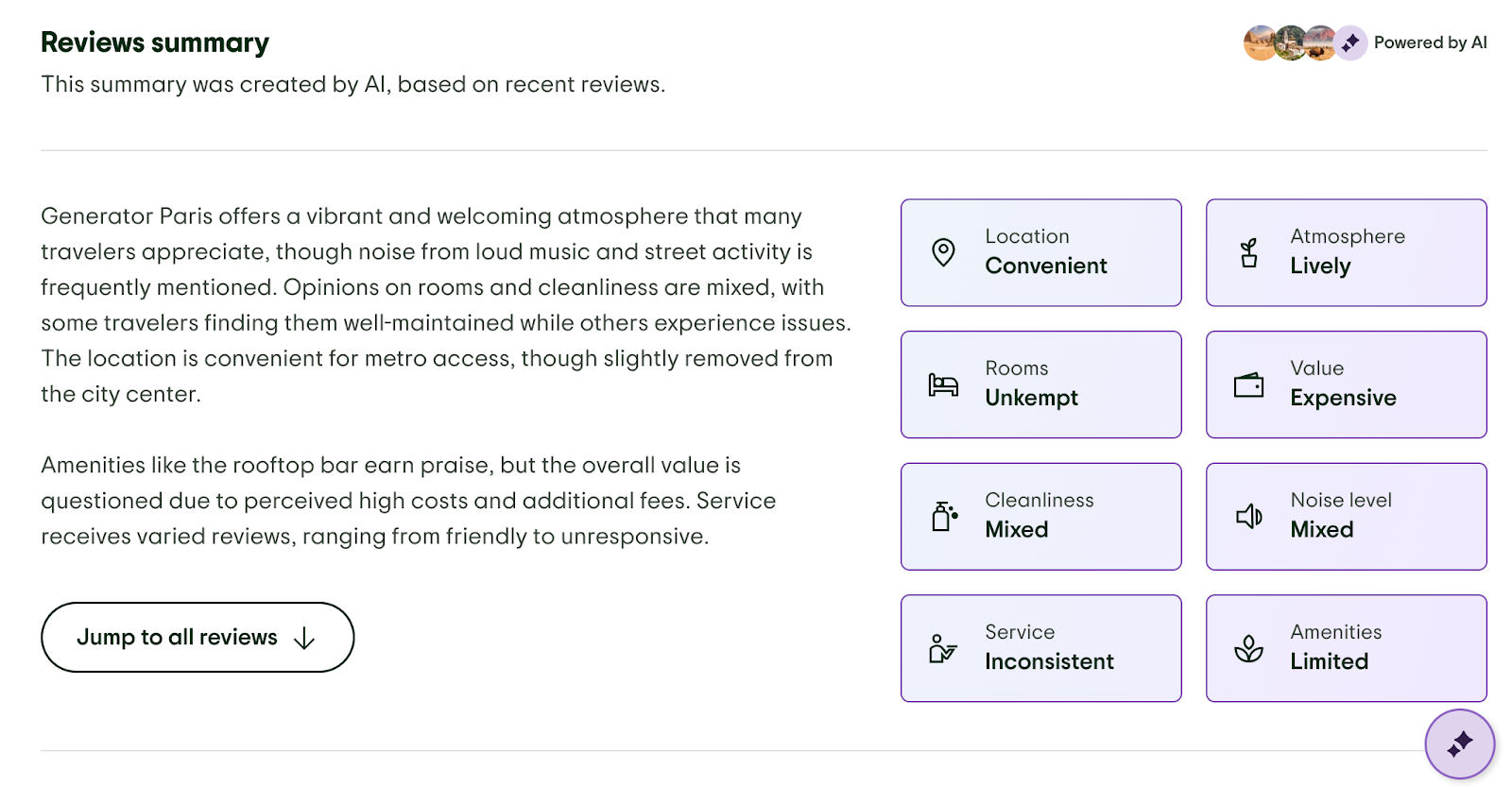
Tripadvisor’s reviews summary
Booking.com joined the party, too. Their AI Review Summaries use OpenAI’s GPT-4o mini model to analyze thousands of user-generated reviews and distill them into short, theme-based summaries. The feature works by combining Booking.com's structured data with unstructured review content to surface insights that are both relevant and easy to act on.
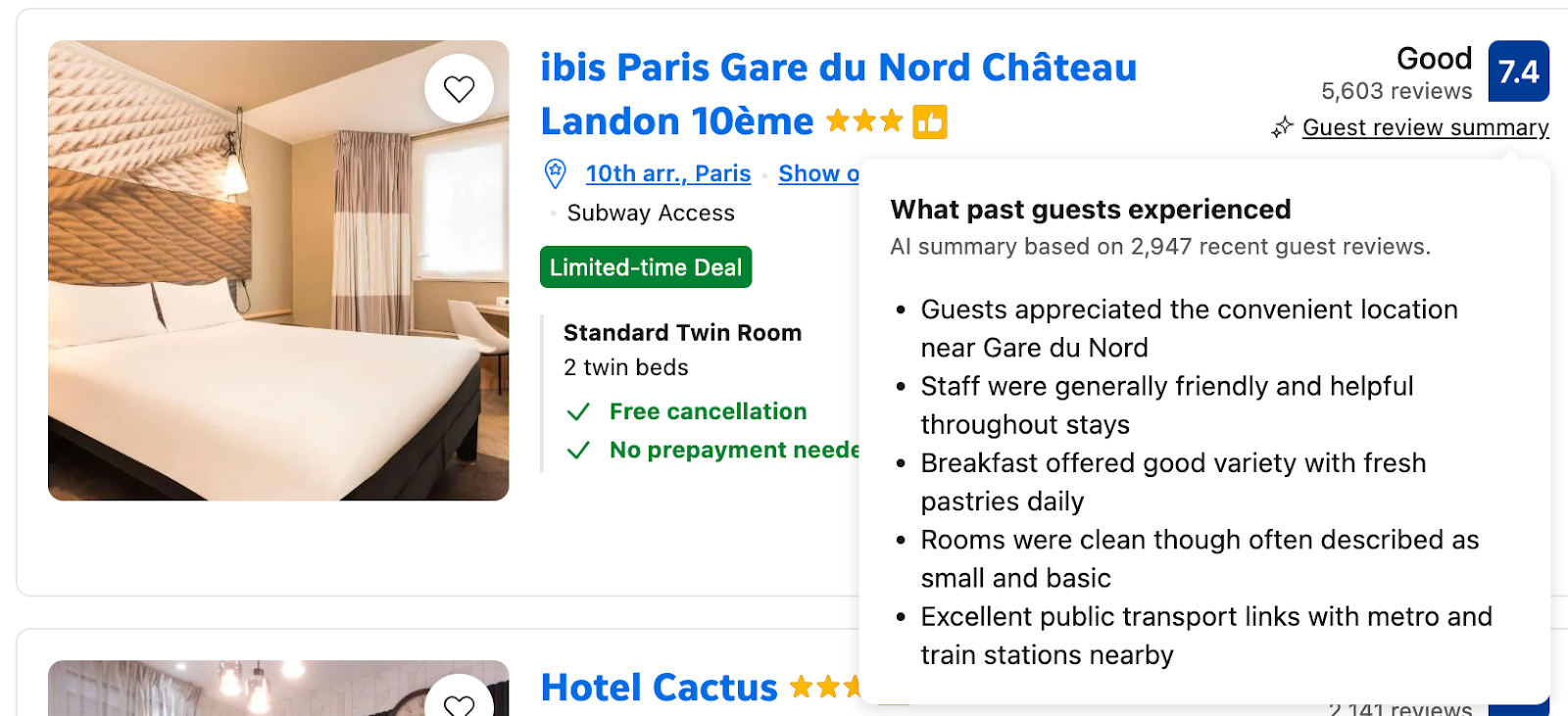
AI summary of reviews on Booking.com
The potential benefits are substantial. Review summarization can save travelers time, improve decision-making, and reduce the frustration of sifting through conflicting opinions. For travel platforms, it enhances engagement, builds trust, and makes user-generated content more actionable.
But will it take away from the real human reviews? Tomotaka doesn’t think so.
“Generative AI is excellent at gathering and presenting general information quickly. But travel is about experiences, and human advisors can provide immersive, personalized insights that AI cannot. The future will likely combine both: AI for efficiency and discovery, and humans for deeper, more tailored advice.”
Customer service automation
By applying AI to customer service, travel can tackle one of the most complex operational challenges in the industry: delivering fast, accurate, and personalized support at scale. That’s probably why Airbnb started its transformation into an AI-first company from this exact problem.
“Customer service is the hardest problem because the stakes are high, you need to answer this quickly and the risk of hallucination is very, very high, and you cannot have a high hallucination rate,” said Brian Chesky, Airbnb’s CEO.
Airbnb’s AI customer agent is powered by 13 models trained on tens of thousands of past conversations. Next year, the company plans to expand it to more languages and make it even more personalized and agentic.
AI agents are more than conversational tools – they can process information and take autonomous action. So, if you want, say, cancel a reservation, the agent will know which one, cancel it for you, and even start helping you plan your next trip. There’s more detail into the anatomy of AI agents in our previous article, so make sure to check it after this one.
Enhanced revenue management
Revenue management is at the heart of hotel strategy – essentially the art and science of selling the right room, at the right price, to the right customer, at the right time. Traditionally, it involves analyzing historical booking patterns, market demand, competitor pricing, and seasonal trends to optimize room rates and maximize revenue.


Revenue Management - the science of ultimate hotel success
What could the role of gen AI be in that?
“Revenue management has long been advancing with the use of various models,” says Tomotaka. “Now, it will be possible to link demand forecasts, resource allocation, and ingredient procurement all at once, allowing us to find the optimal solution based on the overall trend.”
Beyond simply adjusting room rates, gen AI could revolutionize the whole revenue optimization process in hotels.
Klaus Kohlmayr of IDeaS envisions more conversational, assistant-like interfaces for pricing, forecasting, and troubleshooting, while Kevin Duncan of Cendyn highlights AI’s ability to simulate scenarios and proactively optimize rates based on factors like local events, weather, and competition. Chris Crowley of Duetto emphasizes that AI can handle data-heavy tasks, allowing human managers to focus on scenario planning, strategy, and personalized decisions.
One interesting solution is offered by a provider of price predicting solutions for aviation – Fetcherr.
Similar to how image-generation models learn from vast datasets of labeled images to understand colors, shapes, and patterns, Fetcherr’s LMM (Large Market Model) has been trained on extensive market data. It has internalized concepts like pricing strategies, competition, demand elasticity, flight schedules, and external factors such as weather, news, events, and oil prices.
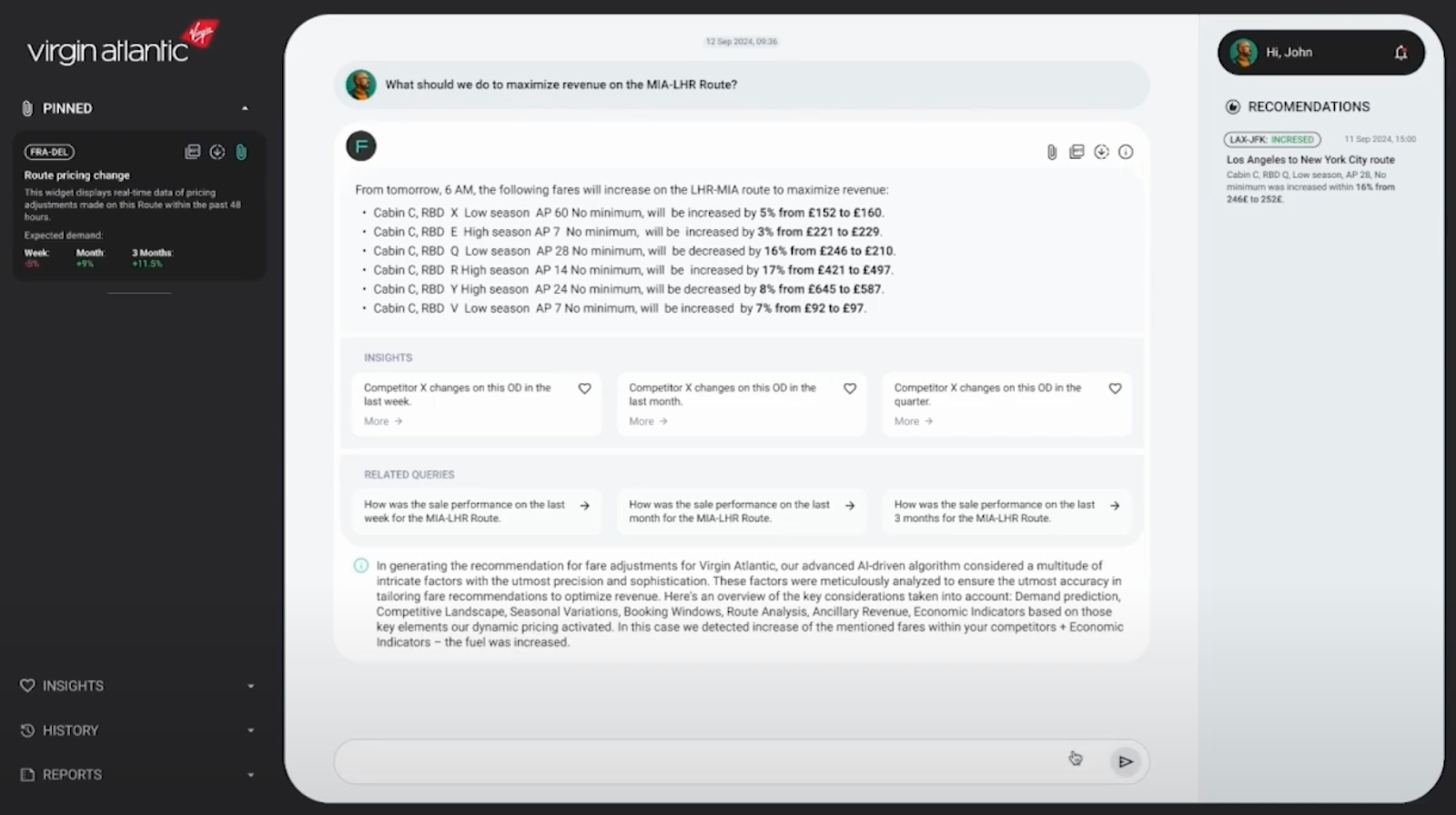
Example of an airline analyst chatting with a Large Market Model. Source: Fetcherr
To communicate well with the humans, they made these insights available via a chat interface, so that business analyst in the company can ask for specific instructions and reports in a traditional conversational manner.
Fetcherr built specialized data pipelines, infrastructure, and deep learning models tailored to market analytics, allowing real-time, highly detailed forecasts.
Kohlmayr and Crowley believe that all tech will become conversational in the next five years, leading to the democratization of revenue management regardless of skill or experience.
It’s a feeling shared widely across the travel industry. A few early applications are surfacing, and debate is intensifying, but meaningful progress is still scarce. Let’s explore why.
The challenges of bringing generative AI into travel
In a recent article, PhocusWire interviewed industry leaders on the pace of adoption of generative AI in tourism. And their response is nearly unanimous: “We’re still very, very early in this game.”
Tomotaka supports this sentiment by raising another issue: “The tourism industry is dominated by small and medium-sized enterprises. These companies are often hesitant to adopt new technologies or change their business models and operations. Because of that, AI adoption in tourism remains limited.”
True, the industry faces a tangle of operational, technical, and ethical hurdles that will determine how fast (and how well) the technology can be adopted. What are those, and how can they be overcome?
Legacy systems and fragmented data
Many travel companies still run on decades-old systems with inconsistent data standards. Connecting these with modern AI platforms is a major technical challenge.
Without unified data lakes, clean APIs, and architectures designed for interoperability, AI cannot operate at its full potential. “This is a legacy issue, and if businesses don't shift to an architecture that allows for easy connection with other systems, they will continue to face problems. Using this opportunity to redesign the architecture is one way to tackle this,” adds Tomotaka.
Personalization vs data gaps
“Travel is relatively infrequent, so relying only on past travel data isn’t enough,” notes Tomotaka. “AI will need to pull from people’s everyday life data – their routines, interests, even recent life changes.”
That raises the question: how do you capture that information without being intrusive? The answer may lie in new forms of traveler-led data sharing, closer to Vendor Relationship Management (VRM).
VRM flips the traditional customer-business data dynamic on its head. In the conventional model of Customer Relationship Management (CRM), companies collect and analyze consumer data to deliver targeted offers and experiences. But as privacy concerns grow, this approach is becoming less sustainable. VRM offers an alternative: Instead of businesses passively harvesting data, individuals actively decide what personal information to share, when, and with whom, in exchange for better, more relevant services.
The core idea behind VRM is empowerment. Each person manages their own data and selectively shares it with service providers who can offer value in return. In a tourism context, this could mean a traveler’s AI agent sharing their preferences directly with hotels, airlines, or destinations to surface options that align with their exact needs, rather than relying on guesswork from fragmented booking histories. VRM provides a more complete picture of traveler behavior and opens the door to hyper-personalized experiences built on trust and transparency.
Tomotaka is optimistic about this possibility. “I believe travelers will start selecting platforms and suppliers like hotels to share their information with. I think this will lead to a service that's not a perfect VRM, but something in between CRM and VRM, or perhaps leaning more towards VRM.”
Shifting industry dynamics
Generative AI has the potential to reshape the balance of power between online travel agencies, suppliers, and travelers. Instead of simply browsing listings, travelers may soon express vague needs like “a riverside cabin with stargazing within two hours of Prague” and expect AI to deliver options. This could allow hotels and airlines to connect with demand more directly, potentially bypassing OTAs. But OTAs could also reinvent themselves – returning to their original role as interpreters of traveler intent, much like human travel agents once did.
Supplier readiness
Even if AI systems can capture live traveler demands, suppliers need to be ready to respond.
Tomotaka provides a handy analogy: “Think of it like Uber: the traveler expresses a need, and nearby suppliers respond if they can fulfill it.”
But unlike hailing a taxi, fulfilling a trip often involves multiple providers – transport, lodging, dining, activities – all coordinating seamlessly. For suppliers, preparing for this future means rethinking how they expose inventory, share data, and compete for demand in real time.
Privacy and trust
With personalization comes the responsibility of handling sensitive data. Travelers will hesitate to share personal details with companies that lack robust security practices. If AI is to act as a trusted travel companion, the industry must strike a careful balance between personalization and privacy. Strong security, transparent policies, and brand trust will be as important as the algorithms themselves.
Beyond the hype
The conversation around AI in tourism often circles back to personalization and automation – both powerful, but only part of the story. One of the most exciting, and under-discussed, applications is matching: using generative AI to connect traveler needs with supplier offerings in ways that were previously invisible.
In Tomotaka’s words, “What I mean by "matching" is not just an automated process. It's a system that empowers suppliers by making demand visible to them.”
Instead of relying on travelers to scroll through endless OTA listings, AI could surface unspoken or vague preferences and match them with suppliers eager to meet that demand. This shift doesn’t just streamline choice; it redistributes power, giving suppliers clearer visibility into what travelers actually want.
The implications stretch far beyond efficiency. By better visualizing and interpreting demand, AI could help redirect flows of travelers away from overcrowded hotspots toward lesser-known destinations, easing overtourism and creating opportunities for regions that have long remained off the map.
At the same time, automation doesn’t have to mean fewer jobs – rather, it frees staff to focus on what hospitality does best: adding human warmth and value. AI may handle data crunching and logistics, but people remain essential for empathy, creativity, and truly memorable guest experiences.
In terms of what comes next, Tomotaka believes that “search” as we know it will transform significantly in the next two or three years. “However, the fundamental use of generative AI will likely take a bit more time. If the way we search and the way suppliers present information don't dramatically change within the next two or three years to adapt to generative AI's conversational format, I believe they will be left behind.”

Maryna is a passionate writer with a talent for simplifying complex topics for readers of all backgrounds. With 7 years of experience writing about travel technology, she is well-versed in the field. Outside of her professional writing, she enjoys reading, video games, and fashion.
Want to write an article for our blog? Read our requirements and guidelines to become a contributor.

